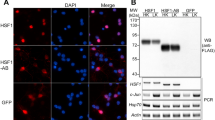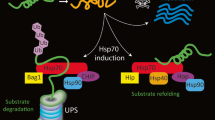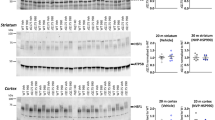Summary
1. Altered mRNA levels in postmortem brain tissue from persons with Alzheimer's disease (AD) or other neurological diseases are usually presumed to be characteristic of the disease state, even though both agonal state (the physiological state immediately premortem) and postmortem interval (PMI) (the time between death and harvesting the tissue) have the potential to affect levels of mRNAs measured in postmortem tissue. Although the possible effect of postmortem interval on mRNA levels has been more carefully evaluated than that of agonal state, many studies assume that all mRNAs have similar rates of degradation postmortem.
2. To determine the postmortem stability of inducible heat shock protein 70 (hsp70) mRNAs, themselves unstablein vivo at normal body temperature, rats were heat shocked in order to induce synthesis of the hsp70 mRNAs. hsp70 mRNA levels in cerebellum and cortex were then compared to those of their heat shock cognate 70 (hsc70) mRNAs, as well as to levels of 18S rRNAs, at 0 and at 24 hr postmortem.
3. Quantiation of northern blots after hybridization with an hsp70 mRNA-specific oligo probe indicated a massive loss of hsp70 mRNA signal in RNAs isolated from 24-hr postmortem brains; quantitation by slot-blot hybridization was 5- to 15-fold more efficient. Even using the latter technique, hsp70 mRNA levels were reduced by 59% in 24-hr-postmortem cerebellum and by 78% in cortex compared to mRNA levels in the same region of 0-hr-postmortem brain. There was little reduction postmortem in levels of the hsp70 mRNAs or of 18S rRNAs in either brain region.
4.In situ hybridization analysis indicated that hsp70 mRNAs were less abundant in all major classes of cerebellar cells after 24 hr postmortem and mRNAs had degraded severalfold more rapidly in neurons than in glia. There was no corresponding loss of intracellular 18S rRNA in any cell type.
5. We conclude from these results that the effect of postmortem interval on mRNA degradation must be carefully evaluated when analyzing levels of inducible hsp70 mRNAs, and perhaps other short-lived mRNAs, in human brain.
Similar content being viewed by others
References
Barton, A. J. L., Pearson, R. C. A., Najlerahim, A., and Harrison, P. J. (1993). Pre- and postmortem influences on brain RNA.J. Neurochem. 61:1–11.
Border, B., Pardue, S., Miller, E. K., and Morrison-Bogorad, M. (1991). Stress-induced alteration of APP mRNAs.Soc. Neurosci. Abstr. 17:1444.
Brown, I. R. (1990). Induction of heat shock (stress) genes in the mammalian brain by hyperthermia and other traumatic events: A current perspective.J. Neurosci. Res. 27:247–255.
Burke, W. J., O'Malley, K. L., Chung, H. D., Harmon, S. K., Miller, J. P., and Berg, L. (1991). Effect of pre- and postmortem variables on specific mRNA levels in human brain.Brain Res. Mol. Brain Res. 11:37–41.
Clark, A. W., Krekoski, C. A., Parhad, I. M., Liston, D., Julien, J.-P., and Hoar, D. I. (1989). Altered expression of genes for amyloid and cytoskeletal proteins in Alzheimer cortex.Ann. Neurol. 25:331–339.
Denhardt, D. T. (1966). A membrane-filter technique for the detection of complementary DNA.Biochem. Biophys. Res. Commun. 23:641–646.
Floros, J., Phelps, D. S., deMello, D. E., Longmate, J., Harding, H., Benson, B., and White, T. (1991). The utility of postmortem lung for RNA studies; Variability and correlation of the expression of surfactant proteins in human lung.Exp. Lung Res. 17:91–104.
Gilmore, J. H., Lawler, C. P., Eaton, A. M., and Mailman, R. B. (1993). Postmortem stability of dopamine D1 receptor mRNA and D1 receptors.Brain Res. Mol. Brain Res. 18:290–296.
Griffin, W. S. T., Ling, C., White, C. L., III, and Morrison-Bogorad, M. (1990). Polyadenylated messenger RNA in paired filament-immunoreactive neurons in Alzheimer Disease.Alz. Dis. Assoc. Disord. 4:69–78.
Harrison, P. J., and Pearson, R. C. A. (1990).In situ hybridization histochemistry and the study of gene expression in the human brain.Prog. Neurobiol. 34:271–312.
Harrison, P. J., Barton, A. J., Najlerahim, A., and Pearson, R. C. (1990). Distribution of a kainate/AMPA receptor mRNA in normal and Alzheimer brain.Neuroreport 1:149–152.
Harrison, P. J., Proctor, A. W., Barton, A. J., Lowe, S. L., Najlerahim, A., Bertolucci, P. H., Bowen, D. M., and Pearson, R. C. (1991). Terminal coma affects messenger RNA detection in post mortem human temporal cortex.Brain Res. Mol. Brain Res. 9:161–164.
Harrison, P. J., Procter, A. W., Exworthy, T., Roberts, G. W., Najlerahim, A., Barton, A. L. J., and Pearson, R. C. A. (1993). Heat shock protein (hsx70) mRNA expression in human brain: Effects of neurodegenerative disease and agonal state.Neuropathol. Appl. Neurobiol. 19:10–21.
Harrison, P. J., Barton, A. J. L., Procter, A. W., Bowen, D. M., and Pearson, R. C. A. (1994). The effects of Alzheimer's disease, other dementias, and premortem course onβ-amyloid precursor protein messenger RNA in frontal cortex.J. Neurochem. 62:635–644.
Holbrook, N. J., Carlson, S. G., Choi, A. M., and Fargnoli, J. (1992). Induction of hsp70 gene expression by the antiproliferative prostoglandin PGA2; A growth-dependent response mediated by activation of heat shock transcription factor.Mol. Cell Biol. 12:1528–1534.
Hunt, C., and Morimoto, R. I. (1985). Conserved features of eukaryotichsp70 genes revealed by comparison with the nucleotide sequence of human hsp70.Proc. Natl. Acad. Sci. USA 82:6455–6459.
Ilaria, R., Wines, D., Pardue, S., Jamison, S., Ojeda, S. R., Snider, J., and Morrison, M. R. (1985). A rapid microprocedure for isolating RNA from multiple samples of human and rat brain.J. Neurosci. Methods 15:165–174.
Johnson, S. A., Morgan, D. G., and Finch, C. E. (1986). Extensive postmortem stability of RNA from rat and human brain.J. Neurosci. Res. 16:267–280.
Jurivich, D. A., Sistonen, L., Sarge, K., and Morimoto, R. I. (1994). Arachidonate is a potent modulator of human shock gene transcription.Proc. Natl. Acad. Sci. USA 91:2280–2284.
Leonard, S., Logel, J., Luthman, D., Casanova, M., Kirch, D., and Freedman, R. (1993). Biological stability of mRNA isolated from human postmortem brain collections.Biol. Psych. 33:456–466.
Lin, S.-C., and Morrison-Bogorad, M. (1990). Developmental expression of mRNAs encoding thymosinsβ 4 andβ 10 in rat brain and other tissues.J. Mol. Neurosci. 2:35–44.
Lukiw, W. J., Wong, L., and McLachlan, D. R. (1990). Cytoskeletal messenger RNA stability in human neocortex: Studies in normal aging and in Alzheimer's disease.Int. J. Neurosci. 55:81–88.
Manzerra, P., Rush, S. J., and Brown, I. R. (1993). Temporal and spatial distribution of heat shock mRNA and protein (hsp70) in the rabbit cerebellum in response to hyperthermia.J. Neurosci. Res. 36:480–490.
Marotta, C. A., Brown, B. A., Strocchi, P., Bird, E. D., and Gilbert, J. M. (1981). In vitro synthesis of human brain proteins including tubulin and actin by purified brain polysomes.J. Neurochem. 36:966–975.
Maschhoff, K., White, C. L., III, Jennings, L. W., and Morrison-Bogorad, M. (1989). Ribonuclease activities and distribution in Alzheimer's and control brains.J. Neurochem. 52:1071–1078.
Miller, E. K., Raese, J. D., and Morrison-Bogorad, M. (1991). The expression of heat shock protein 70 and heat shock cognate 70 messenger RNAs in rat cortex and cerebellum after heat shock or amphetamine treatment.J. Neurochem. 56:2060–2071.
Morrison, M. R. (1988). mRNA levels in neurological disease. InThe Molecular Biology of Neurological Disease (R. N. Rosenberg and A. Harding, Eds.), Butterworths, London, pp. 135–152.
Morrison, M. R., and Griffin, W. S. T. (1981). The isolation andin vitro translation of undegraded messenger RNAs from human postmortem brain.Anal. Biochem. 113:318–324.
Morrison, M. R., and Rosenberg, R. N. (1983). Specific messenger RNA changes in Joseph disease cerebella.Ann. Neurol. 14:73–79.
Morrison, M. R., Pardue, S., and Griffin, W. S. T. (1983). Altered expression of different tubulin electrophoretic variants during human cortex development.J. Neurogenet. 1:105–111.
Morrison, M. R., Griffin, W. S. T., and White, C. L., III (1985). Brain messenger RNA in Alzheimer disease. InRole of RNA and DNA in Brain Function (A. Giuditta, B. B. Kaplan, and C. Zomzely-Neurath, Eds), Martinus Nijhoff, Boston, pp. 142–159.
Morrison-Bogorad, M., Groshan, K., Pardue, S., Border, B., Miller, E. K., and Raese, J. D. (1991). Differential expression of members of the heat shock gene family in brain of adult and aged rats. InAlzheimer's Disease: Basic Mechanisms, Diagnosis and Therapeutic Strategies (K. Iqbal, D. R. C. McLachlan, B. Winblad, and H. M. Wisniewski, Eds), John Wiley & Sons, Chichester, England, pp. 243–252.
Morrison-Bogorad, M., Pardue, S., Miller, E. K., and Raese, J. D. (1992). The stress response, cell death and aging in rat and human brain.Neurochem. Int. 21 (Suppl):A5.
Morrison-Bogorad, M., Zimmerman, A. L., and Pardue, S. (1993). The heat shock response in Alzheimer disese brain.J. Neurochem. 61 (Supp.):S178.
Morrison-Bogorad, M., Pardue, S., McIntire, D. D., and Miller, E. K. (1994). Cell size and the heat shock response in rat brain.J. Neurochem. 63:857–867.
Morrison-Bogorad, M., Zimmerman, A. L., and Pardue, S. (1995). Heat shock 70 messenger RNA levels in human brain: Correlation with agonal fever.J. Neurochem. 64:235–246.
Noguchi, I., Arai, H., and Iizuka, R. (1991). A study on postmortem stability of vasopressin messenger RNA in rat brain compared with those in total RNA and ribosomal RNA.J. Neural Transm. Gen. Sect. 83:171–178.
Pardue, S., Groshan, K., Raese, J. D., and Morrison-Bogorad, M. (1992). Hsp70 mRNA induction is reduced in neurons of aged rat hippocampus after thermal stress.Neurobiol. Aging 13:661–672.
Pardue, S., White, C. L., III, Bigio, E., and Morrison-Bogorad, M. (1994). Anomalous binding of radiolabeled oligonucleotide probes to plaques and tangles in Alzheimer disease hippocampusMol. Chem. Neuropathol. 22:1–24.
Pearson, R. C. A., Barton, A. J. L., Heath, P. R., and Harrison, P. J. (1992). Changes in messenger RNA in dementia. InNeurodegeneration, Academic Press, London, pp. 151–165.
Perrett, C. W., Marchbanks, R. M., and Whatley, S. A. (1988). Characterization of messenger RNA extracted post-mortem from the brains of schizophrenic, depressed and control subjects.J. Neurol. Neurosurg. Psych. 51:325–331.
Petersen, R., and Lindquist, S. (1988). TheDrosophila hsp70 message is rapidly degraded at normal temperatures and stabilized by heat shock.Gene 72:161–168.
Phillips, H. S., Hains, J. M., Armanini, M., Laramee, G. R., Johnson, S. A., and Winslow, J. W. (1991). BDNF mRNA is decreased in the hippocampus of individuals with Alzheimer's disease.Neuron 7:695–702.
Rivkees, S. A., Chaar, M. R., Hanley, D. F., Maxwell, M., Reppert, S. M., and Uhl, G. R. (1989). Localization and regulation of vasopressin mRNA in human neurons.Synapse 3:246–254.
Roses, A. D., Gilbert, J. R., Bartlett, R. J., Pericak-Vance, M. A., Dawson, D. V., and Morrison, M. R. (1987). Sib-pair linkage and subtraction hybridization strategies for Alzheimer's disease.Banbury Rep. 27:443–458.
Ross, B. M., Knowler, J. T., and McCulloch, J. (1992). On the stability of messenger RNA and ribosomal RNA in the brains of control human subjects and patients with Alzheimer's disease.J. Neurochem. 58:1810–1819.
Somerville, M. J., Percy, M. E., Bergeron, C., Yoong, L. K., Grima, E. A., and McLachlan, D. R. (1991). Localization and quantitation of 68 kDa neurofilament and superoxide dismutase-1 mRNA in Alzheimer brains.Brain Res. Mol. Brain Res. 9:1–8.
Stopa, E. G., Uhl, G. R., O'Hara, B. F., Chorsky, R. L., King, J. C., Bird, E. D., and Wolfe, H. (1992). Somatostatin-gene expression in the postmortem adult and fetal human brain.Peptide Res. 5:201–205.
Theodorakis, N. G., and Morimoto, R. I. (1987). Posttranscriptional regulation ofhsp70 expression in human cells' Effects of heat shock, inhibition of protein synthesis and adenovirus infection on translation and mRNA stability.Mol. Cell. Biol. 7:4357–4368.
Yost, H. J., Petersen, R. B., and Lindquist, S. (1990). RNA metabolism: strategies for regulation in the heat shock response.Trends Genet. 6:223–227.
Author information
Authors and Affiliations
Rights and permissions
About this article
Cite this article
Pardue, S., Zimmerman, A.L. & Morrison-Bogorad, M. Selective postmortem degradation of inducible heat shock protein 70 (hsp70) mRNAs in rat Brain. Cell Mol Neurobiol 14, 341–357 (1994). https://doi.org/10.1007/BF02088715
Received:
Accepted:
Issue Date:
DOI: https://doi.org/10.1007/BF02088715




